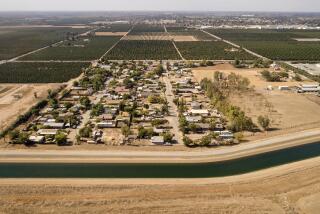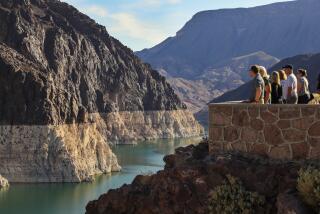The Market Dries Up for a Book on Drought : Publishing: A cooler, wetter summer dampened, but hasn’t dashed, the hopes of a small Venice press that produced water-saving guide. They say Californians will always need it.
- Share via
At first, the timing seemed perfect for everybody.
It was early last March, and William Slater and Peter Orzechowski had sold the manuscript for their “Drought Busters” consumer handbook on the first try.
Venice publishers Joshua Horwitz and Stephen Tukel had also been feeling smug over buying the book, which had come in--miraculously, they thought--over their transom at Living Planet Press.
The publishers had been watching a growing public scramble to save water as the dry season intensified last winter and Draconian rationing plans were announced statewide.
Clearly a “how to” book would be a bestseller. And, just as Horwitz and Tukel were wishing they had such a book, the manuscript “Drought Busters: 30 Easy Ways to Save Water . . . and Money” appeared. The authors were not environmentalists, but ordinary people who became frustrated while calling utilities and plumbing suppliers and gardening magazines, piecing together information about ways to economize.
Their book was a concise, organized reference, says Horwitz. “It’s not so often that you get ahead of the curve.” The publishers, whose year-old press specializes in environmental issues, put everything else on hold and concentrated on whisking “Drought Busters” into production. “To be honest,” Horwitz says, “as a small press, we felt like our ship had come in.”
And then a series of rainstorms seemingly busted the drought.
“It started raining and just didn’t stop,” recalls Slater. “It was incredible.”
There was more. A summer of record cool, cloudy weather made the drought seem a matter of history.
While such news might have washed away their hopes, the publishers kept with their plan, although it meant lowering their sights. “Last March we could have advanced 100,000 copies of this book,” Horwitz says. “As it is, we’ve advanced 5,000.” Stores are still ordering the paperback book, which retails for $5.95, but in cautious quantities.
The publishers say that even if the sense of urgency has diminished, Californians will always need to save water.
“We decided to publish this book because it was clear to us that specific droughts come and go, but there is a permanent water shortage here,” says Tukel. “What people tend to forget is that California is essentially facing a permanent drought.”
But memories are improving.
In Sacramento, the state Drought Information Center reports a statewide conservation average of 20% to 25% this summer over last. Says staff member Dee Davis: “Most of the people we talk to understand not only that California is a desert area, but (that) it’s so fast-growing we have to conserve. They are very water-conscious: it’s surprising how much they know about the state situation.”
Public reaction to “Drought Busters” seems to confirm Davis’ contention that, despite the benign summer, last winter’s water-crisis headlines have not been forgotten.
Slater and Orzechowski have just finished a promotional sweep through the state and said they picked up some common themes from bookstore conversations and radio call-in audiences.
“It wasn’t public panic, but there was a real gut-level concern,” says Slater, a consultant for a Manhattan Beach health center.
Callers were particularly upset about issues of fairness, says Slater, who was raised in California. “They felt they worked hard to save water, and then their rates got increased. And they think farmers are using more water than they need.”
“People used the radio call-ins for venting their anger,” says Orzechowski, a German-born environmental writer who moved to Hermosa Beach in 1986. “And in Northern California (where 80% of the state’s precipitation falls) they’re angry about us down here, and in Southern California (where 80% of the state’s population lives), we’re angry about them. I’d heard about that antagonism, and hadn’t believed it, but there is some difference.”
“We don’t have a drought in Germany, but the big issue that always strikes me there strikes me here even more: We are wasters.” He thinks last winter’s crisis was an important consciousness-raiser, and that, in responding with higher rates, the utility companies are making a strategic error.
“I talk to a lot of people,” he says. “They have changed their habits of water consumption, which is very, very good, but they need behavior modification--they need good feedback.”
Publisher Tukel also believes the utilities should change their ways--by offering more public education programs. He mailed copies of his book to the state’s 100 largest utilities and water agencies but found no takers.
Utilities say they aren’t in the book-buying business. “Most water agencies don’t have the budget to send out a book,” says Jacques DeBra, water conservation coordinator for the city of Davis. “We are just starting to change from an engineers’ world of pumping water to a planner’s world of conserving it.
“We’re starting to think about water systems of the future--maybe tiered billing systems--that would reward people for conserving,” he says.
Tukel remains patient. “Speaking as a publisher, I know what’s going to happen,” he says. “Whether it’s next spring, or three years from now, there will be another ‘drought emergency,’ and this book will be as useful then as it is now.”
More to Read
Sign up for our Book Club newsletter
Get the latest news, events and more from the Los Angeles Times Book Club, and help us get L.A. reading and talking.
You may occasionally receive promotional content from the Los Angeles Times.










